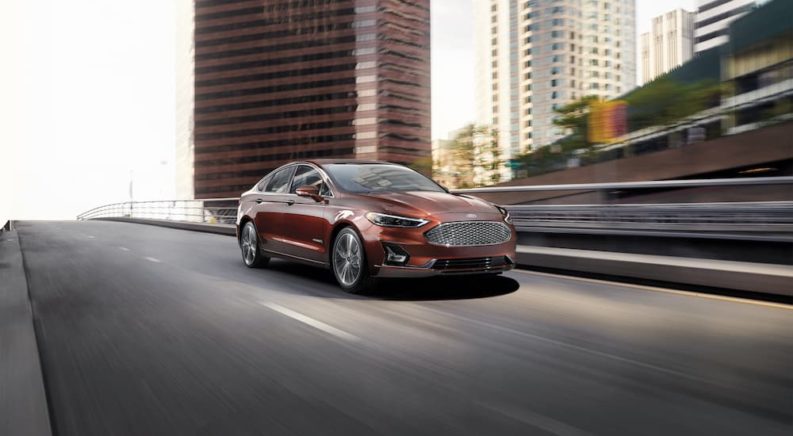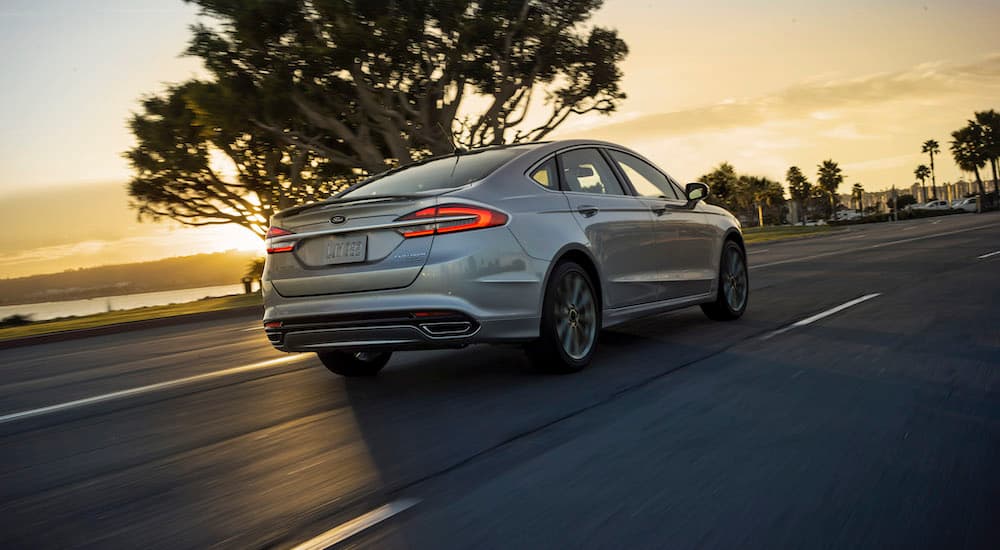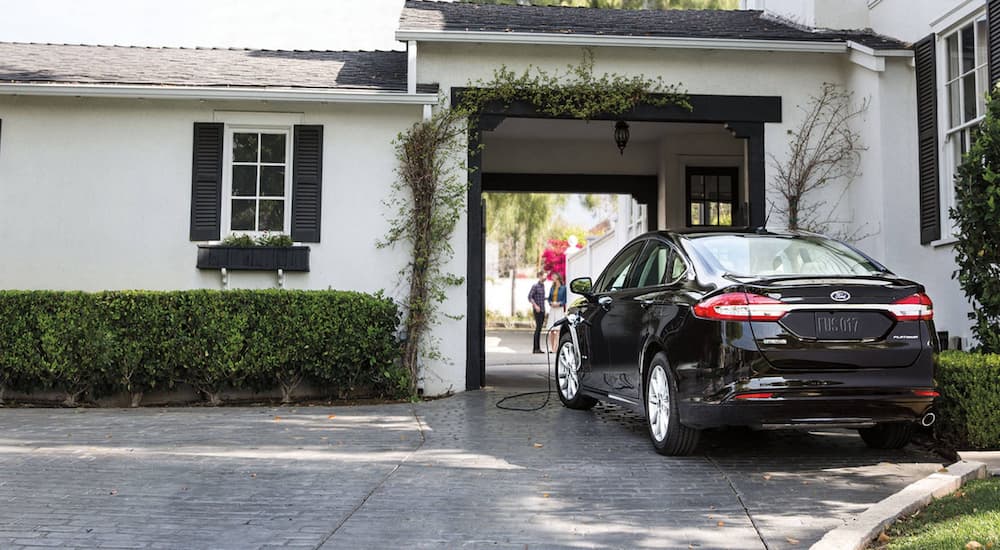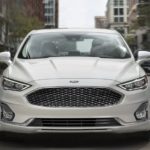When the Ford Fusion first hit the market, it slotted in between the Ford Focus and the Ford Five Hundred. Today, all three models have been discontinued in North America, as Ford has decided to shift its focus to the more popular body styles in its lineup: trucks and SUVs. While tastes overall may have shifted away from sedans, there are plenty of auto enthusiasts who still appreciate them and look back fondly on models that are no longer around.
These days, you’re most likely to find the Fusion among used cars for sale near you, but it spent much of its run embracing the cutting edge, from bold styling to technological advancements. It also won over fans with refined road manners and a practical interior. So let’s take a look at the history of the Ford Fusion, as well as what the future might hold for the beloved nameplate.
2006: The Fusion Is Born
The first Fusion debuted for the 2006 model year. As a midsize sedan, it was up against well-established favorites like the Toyota Camry and Honda Accord. The Fusion stood out from the competition thanks to distinctive styling, with a bold chrome grille in the front and a sleek, modern interior with chrome trim shining brightly against high-gloss black panels. It also stood out thanks to an automatic transmission with six speeds rather than four or five.
2007: Land Speed Record Broken
Not long after the Fusion went into production, Ford created a hydrogen fuel-cell-powered racing version called the Fusion Hydrogen 999. Retired Ford engineer and experienced racing driver Rick Byrnes drove the car at the Bonneville Salt Flats on August 15th, 2007, at speeds of up to 207.279 mph. While it didn’t beat the 314.958 mph set by the Buckeye Bullet in 2004, it did set the record for all fuel cell vehicles, and it made history as the first production-based hydrogen-fuel cell car to run at Bonneville. This stunt was a public display of Ford’s efforts to go green, which would continue in the years to come, especially where the Fusion was concerned.
2010: Hello, Hybrid!
The 2010 Fusion wasn’t a complete redesign, but it did get some significant upgrades inside and out. This included the introduction of a 3.5-liter V6 engine, changes to the body shape to improve aerodynamics, a revamped interior with more soft materials, and an updated infotainment system. There were also changes to the aesthetics, giving the car a sportier appearance.
Perhaps the most significant change for the 2010 model was the addition of a hybrid powertrain. Ford’s small and lightweight yet powerful Nickel-Metal Hydride battery was cutting-edge for the time, giving the Fusion Hybrid impressive power and fuel economy compared to its competitors. Between the electric motor and the 2.5-liter four-cylinder engine, the 2010 Fusion Hybrid can deliver up to 191 horsepower, can go from zero to sixty in 8.5 seconds, and has an EPA rating of 41 MPG in the city and 36 MPG on the highway. Running in EV mode, it can get up to 47 MPG. These figures aren’t too shabby even by today’s standards, and they were pretty much revolutionary for the market at the time.
2013: The Next Generation
The second generation was officially kicked off with the 2013 Fusion. With a new sheet metal design and a larger body, the Fusion’s appearance and dimensions were updated for modern tastes. Under the hood, the V6 engines were replaced with two turbocharged four-cylinder options that improved efficiency, though at the expense of horsepower. In addition to the standard hybrid version, the lineup gained a plug-in hybrid called the Fusion Energi. This option features the same engine and motor as the original hybrid powertrain but has a larger battery pack that can be recharged at an AC outlet. The Energi has 620 total miles of range and can travel up to 21 miles in EV mode.
2017: New Trims & New Tech
Two upper-level trim options were added to the 2017 Fusion. The Sport comes standard with all-wheel drive and a twin-turbo 2.7-liter V6 that can deliver up to 325 horsepower. The Platinum trim offers comfort and luxury, with a richly appointed interior full of premium materials. The Fusion also gained new technology, like adaptive cruise control, automatic stop/start, and a rotary shifter.
2019: Safety Comes Standard
The 2019 model got some subtle styling changes, but the biggest difference between this Fusion and previous ones is the comprehensive suite of standard driver-assistance features. While some of them had been included in higher trim levels or available as optional add-ons in previous years, technologies like blind-spot monitoring, lane-keep assist, automatic high beams, and automated emergency braking were now standard equipment across all of the Fusion’s trim levels. On top of that, the Fusion also gained available onboard Wi-Fi and an updated infotainment system with Waze and Amazon Alexa built-in.
2020: A Simplified Lineup
Having already declared that this would be the car’s last model year, Ford simplified the lineup for the 2020 Fusion. The Sport and Premium trims were dropped, leaving the SE, Titanium, and SEL as the remaining options, though buyers could still choose between various powertrains, including the two hybrid options. The 2020 model did get one last tech upgrade: compatibility with FordPass Connect. Standard on all trims, this allows drivers to start the car, check various vehicle diagnostics, and lock or unlock the car remotely via Ford’s mobile app.
2021: Discontinued
There is no 2021 Ford Fusion. Despite the model’s tremendous versatility, comfortable interior, and refined ride, Ford opted to discontinue it as part of its larger decision to shift away from the car market and focus on its SUVs and trucks. While this was a response to overall consumer demand, there are plenty of fans who will miss this welcome addition to the world of midsize sedans. Of course, those who still want a Fusion can always look for a pre-owned model, but it’s sad to see it go, nevertheless.
2023: Ford Fusion Active
There is hope for a revival on the horizon, however. It seems that Ford will be using the Fusion nameplate for a new lifted station wagon set to debut for the 2023 model year. Similar to the Subaru Outback, the Fusion Active will be essentially a mix between a sedan and a crossover SUV. While not much is confirmed about it as of now, there is reason to believe that it will be offered with hybrid and plug-in hybrid powertrains.
We can only hope that it will carry on the most popular and beloved attributes of the car it shares a nameplate with. The exterior has yet to be revealed, but it will probably pay homage to the style of the Fusion. With the new body style, the interior should be even more spacious, and there’s no reason to think it won’t be just as comfortable and luxurious. As for particular details, we’ll just have to wait and see. Whatever Ford has in the works, it’s nice to see that the company is committed to continuing the Fusion’s legacy.
The Ebb and Flow of the Fusion
The rise and fall of the Fusion mirrors the shifting tastes of North American drivers. In some ways, the Fusion fell out of step with the public as more and more people traded in their sedans for crossovers. However, some of the model’s features proved to have staying power, including its hybrid powertrains and adoption of now-ubiquitous driver-assistance features. The Fusion may no longer be rolling off the assembly line, but it left its mark on the industry, and it may be coming back in a new form very soon.






